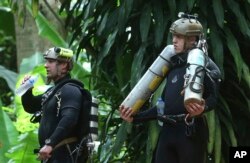For rescuers of 13 young men in Thailand trapped in a flooded cave, there are two major risk factors. One is more rain. The other is panic.
"It's pretty scary being in the dark," Alan Warild, captain of Australia's New South Wales Cave Rescue Squad, told VOA this week. "It's going to be muddy water. They won't be able to see anything. What will really be the hardest thing for the kids is just staying calm."
Warild was discussing the rescue options for the 12 boys aged 11 to 16 and their 25-year-old soccer coach, who were found Monday by British diving specialists. A video taken shortly before their disappearance June 23 shows them careening on bicycles through the rural streets of their village, Mae Sai, under gray skies, wind muffling the sounds of their Saturday afternoon chatter.
The cave system in Chiang Rai province, into which they disappeared, is well-known for its depth and danger. To enter, the boys passed a sign warning people to stay out during the region's rainy season, which lasts from July to November. When the boys entered the cave two weeks ago, the rainy season hadn't officially started.
But the rain had. By the time they were found Monday, the young men had been trapped two kilometers into the damp, pitch-black belly of the mountain for more than a week. The narrow passages between the ledge they were found on and the daylight outside are now filled with cold, murky water. Reportedly, none of them can swim.
Experts say professional divers could guide the boys out, one by one. But it would require complicated diving skills that the boys do not possess — and after nearly two weeks of very little food and water, the five-hour journey to fresh air and sunlight will be even more challenging. A moment of panic in a narrow, flooded passage could spell disaster.
And there is a bigger risk: rain. Emergency workers have been pumping water out of the cave system at a rate of 1.6 million liters an hour. Reports say the water level has dropped 40 centimeters since the pumping started.
'Scene's going to change'
But if more rain begins to fall, Warild said, "then the whole scene's going to change. A lot more water, a lot more current washing people around. Fighting strong currents, you use up a lot of air and a lot of energy."
Family and friends expressed relief when the boys were found, but video of the gaunt, disheveled lost boys released this week has only partially reassured their loved ones. A medical assessment Thursday by medics attending the boys in the cave concluded that neither they nor their coach were strong enough yet to attempt an exit.
Experts have discussed a couple of other rescue scenarios.
The boys have reported hearing the sounds of the outside world while trapped in the cave — although there is no verification that they weren't mistaken or hallucinating. Some experts have noted that they boys have had enough oxygen to breathe. Both factors could indicate that there is another way out of the 10-kilometer cave complex, perhaps a spot where an escape route could be drilled.
"Well, that hasn't been found yet, so there's no guarantee or any good indication that there is another way in," Warild said. "And drilling would take a long time."
Officials have also discussed having the boys remain in their current position until the end of the rainy season, when floodwaters recede, but that would take another four or five months.
Warild suggested a compromise that would buy the rescuers some time: Find a safe halfway point where the boys and rescue divers could take shelter if the cave refloods.
Meanwhile, time is of the essence, and the weather cannot be controlled.
"There's no best option," Warild said.








